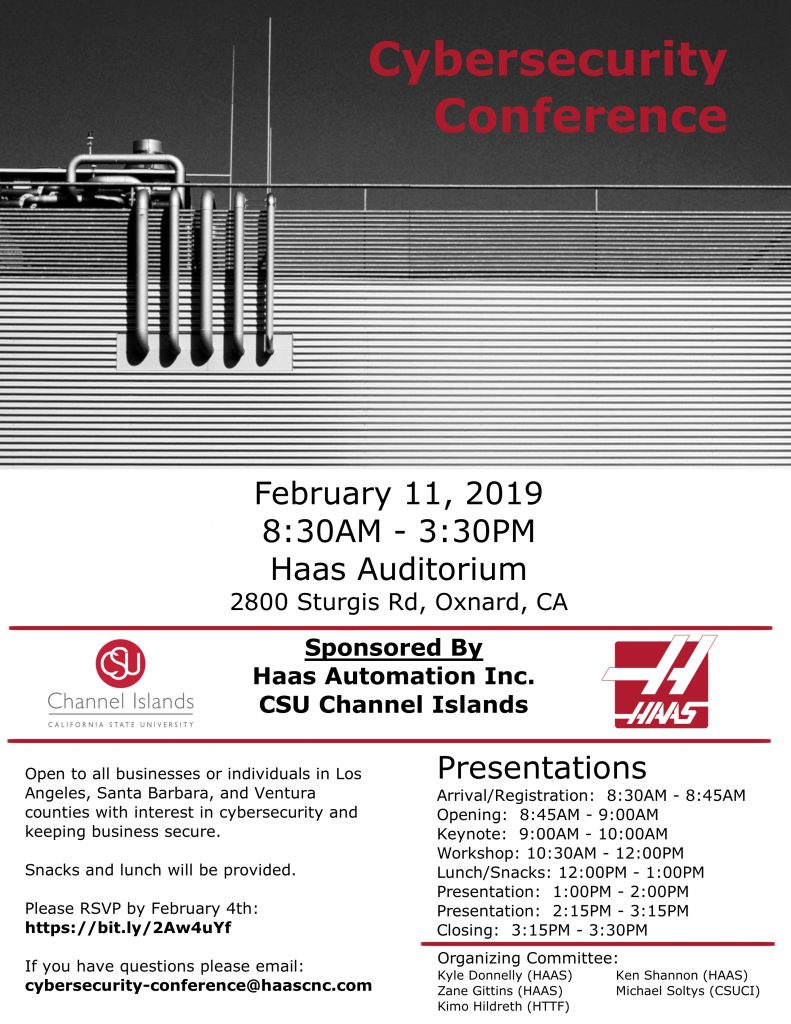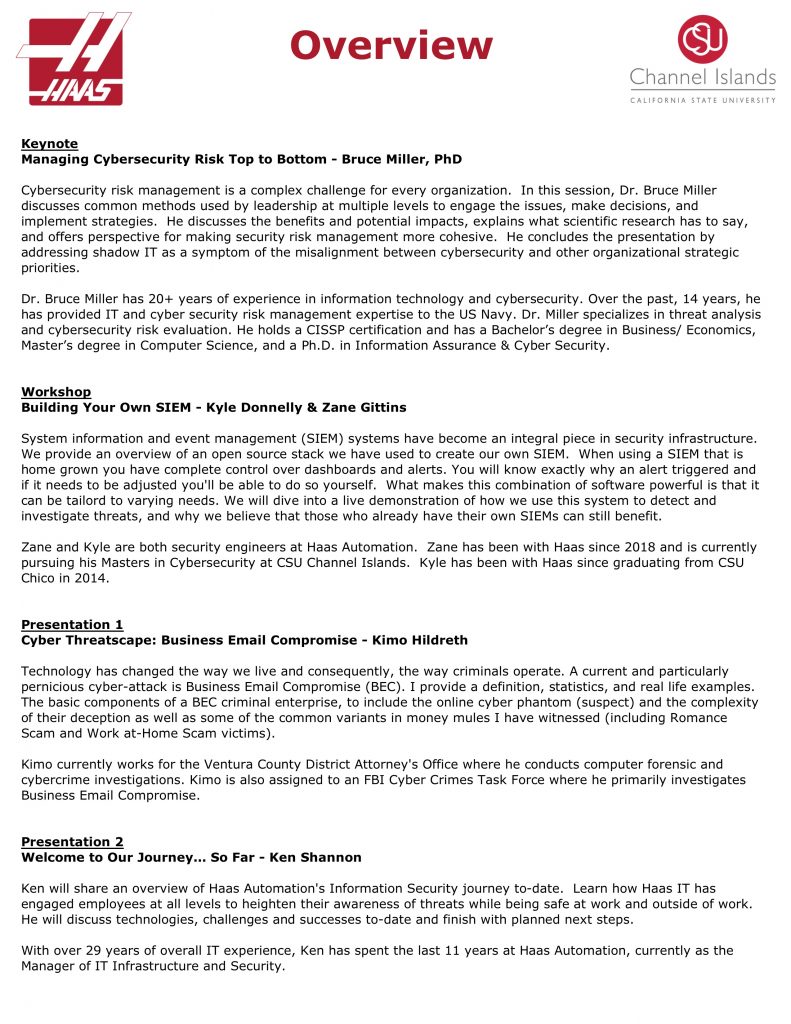On April 17, 2019, I will be speaking at the MIT Forum about Cybersecurity. This event is open to the public. For details:
Blog
CI has a new student Cybersecurity club

Job positions at NAVFAC
Job Title: Student Trainee (Engineer), GS-0899-04
Who may apply: Current students enrolled in an engineering or related accredited program.
Position: Temporary Appointment NTE 1 Year (20 selections may be made)
Open Period: 02/13/19 – 02/19/19
Department: DON, NAVFAC, EXWC
Duty Location: Port Hueneme, CA
Interested applicants apply at: https://www.usajobs.gov/GetJob/ViewDetails/524202100
Automated letters will be sent to you during different stages of the recruitment process and you may check your own status in USAJOBS account; however, if you need more information on the application process or on the status of your application during any part of the recruitment, please contact:
DON Employment Info Center EIC
Phone: 1-800-378-4559
TDD: (858)577-5723
Email: DONEIC@NAVY.MIL
The Case for Dropping Out of College
This is an interesting article. CI is inexpensive ($15K/year, with a lot of students receiving scholarships). But beside that, this article makes me think about how to give our students “more value” for their time invested in our Computer Science department at CI.
The Case for Dropping Out of College
written by Samuel Knoche
 During the summer, my father asked me whether the money he’d spent to finance my first few years at Fordham University in New York City, one of the more expensive private colleges in the United States, had been well spent. I said yes, which was a lie.
During the summer, my father asked me whether the money he’d spent to finance my first few years at Fordham University in New York City, one of the more expensive private colleges in the United States, had been well spent. I said yes, which was a lie.
I majored in computer science, a field with good career prospects, and involved myself in several extracurricular clubs. Since I managed to test out of some introductory classes, I might even have been able to graduate a year early—thereby producing a substantial cost savings for my family. But the more I learned about the relationship between formal education and actual learning, the more I wondered why I’d come to Fordham in the first place.
* * *
According to the not-for-profit College Board, the average cost of a school year at a private American university was almost $35,000 in 2017—a figure I will use for purposes of rough cost-benefit analysis. (While public universities are less expensive thanks to government subsidies, the total economic cost per student-year, including the cost borne by taxpayers, typically is similar.) The average student takes about 32 credits worth of classes per year (with a bachelor’s degree typically requiring at least 120 credits in total). So a 3-credit class costs just above $3,000, and a 4-credit class costs a little more than $4,000.
Read more here – Source: The Case for Dropping Out of College – Quillette
National Engineers Week Banquet Ventura and Santa Barbara Counties Feb 22

For more information click here. This event took place last year (2018),
Positions in Barcelona
Professor Nataša Pržulj is looking for several PhD students to work in analyzing large-scale molecular and patient data to aid personalizing treatment. The successful candidates will work on the prestigious ERC Consolidator grant of Prof. Pržulj titled “Integrated Connectedness for a New Representation of Biology”. The successful candidates will complete a PhD, which will address multiple topics: developing and applying sophisticated models and algorithms carefully tuned to extract relevant biological and medical knowledge from systems-level real-world molecular and medical data, including whole genome sequences, epigenetic data, protein-protein interaction networks, signaling networks, metabolic networks, transcriptional regulation networks, gene and disease ontologies, drug similarity networks, drug-target interactions, drug-drug interactions, patient records, lifestyle data, electronic health records etc.; the aim is to mine these inter-linked heterogeneous networked data for new biological and medical insight that would lead to improving diagnostics, discovering new biomarkers, improving patient stratification and treatment, personalizing treatment and facilitate rational drug development. The successful candidates will join a dynamic research group of Prof. Przulj within BSC. The students will work in a highly sophisticated HPC environment, will have access to systems and computational infrastructures, and will establish collaborations with experts in different areas.
Applications Procedure
Please send the following documents to natasha@bsc.es:
1. A full CV including contact details.
2. Academic transcripts from Undergraduate and MSc.
3. Three letters of recommendation. The references should email their letters directly to natasha@bsc.es before the deadline.
4. A statement of motivation and research interests.
The Hard Part of Computer Science? Getting Into Class
Lured by the prospect of high-salary, high-status jobs, college students are rushing in record numbers to study computer science.
Now, if only they could get a seat in class.
On campuses across the country, from major state universities to small private colleges, the surge in student demand for computer science courses is far outstripping the supply of professors, as the tech industry snaps up talent.
Price of a hack podcat
Invitation to the HAAS/CSUCI Cybersecurity conference
This event is now at capacity; if you didn’t get a spot, we hope that you can join us on October 7th, for the 2nd biannual HAAS/CI Cybersecurity conference.
I would like to invite you to the first meeting of the HAAS and CSUCI Cybersecurity Conference on February 11, 2019. This is going to be a biannual conference, to be held this year at HAAS on Feb 11, and at CSUCI on Oct 7.
- Please RSVP here: https://bit.ly/2Aw4uYf
- Flyer and program
- There is no registration fee.
This conference aims to serve Ventura, Santa Barbara and LA Counties. There is a lot of interest and need in the area of cybersecurity. We have local groups that work in
- business & industry security
- Navy security
- digital forensics
- compliance, policy and law
- research & education
but it will serve all of us well to have a venue where we can all meet, learn about the latest software tools, best practices and certifications, and speak to fellow IT experts who are being proactive in defending businesses and infrastructure.
Please come and attend our first meeting at HAAS in Oxnard, and circulate this flyer among your colleagues and friends. As I said, a flyer with more information, in particular a registration email, will be circulated in January.


Microsoft Open Sources Homomorphic Encryption Library
My student Dragan Rakas and I worked on an early version of this technology in 2013, and we found it to be a very interesting but difficult problem. You can read our about it here.
 Microsoft has open sourced a homomorphic encryption library developed by its Cryptography Research group, saying it “strongly believes” the technology is ripe for use in real-world applications, as it makes the source code available on GitHub. (Here is the link to the GitHub repository.)
Microsoft has open sourced a homomorphic encryption library developed by its Cryptography Research group, saying it “strongly believes” the technology is ripe for use in real-world applications, as it makes the source code available on GitHub. (Here is the link to the GitHub repository.)
Source: Microsoft Open Sources Homomorphic Encryption Library